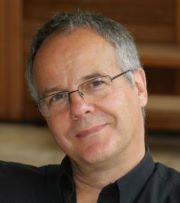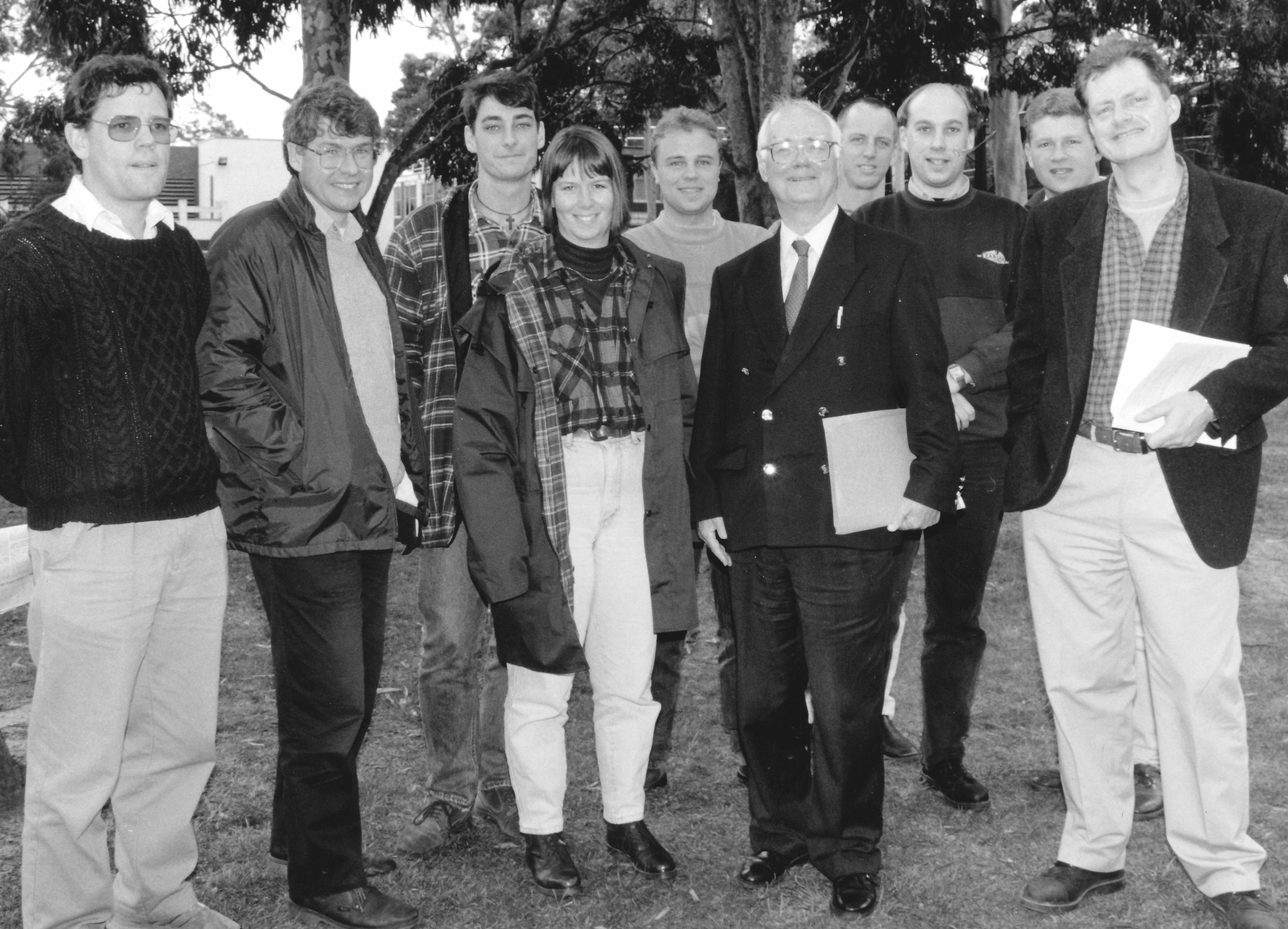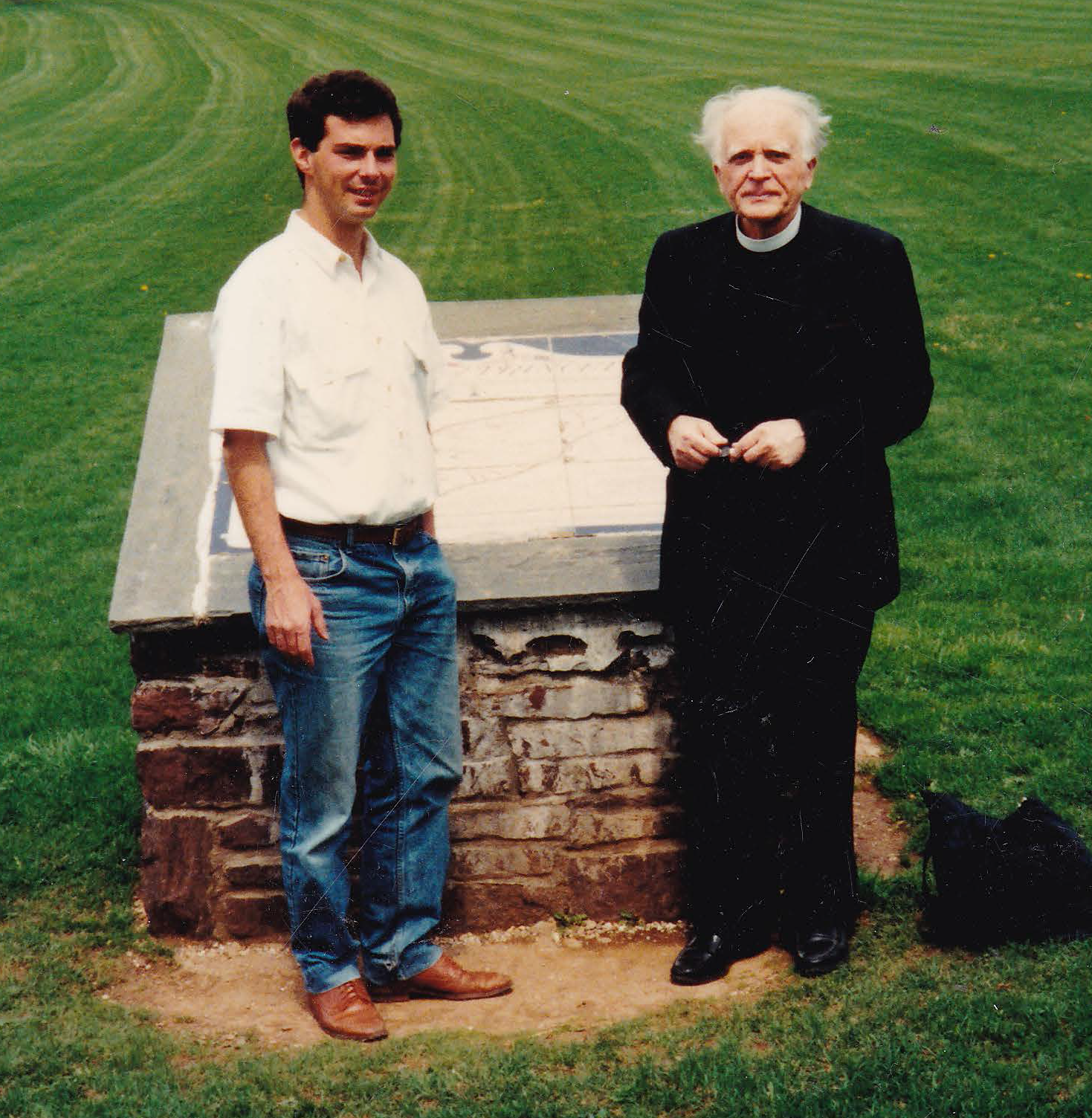


16th September, 2020
Past ISCAST fellow Nick Hawkes reflects in these three articles on the significance of quantum physics for mathematics, atheism and God.
- In “The Challenge of Quantum Physics for Atheism,” Nick proposes that the necessity of an observer “for matter to exist in physical form” is an argument against atheism: reality needs God as the external “observer.” The article reflects on the quantum world’s famous “double slit” experiment. Here, it was found that a subatomic particle collapses from being a “cloud of potential” that is in superposition with itself, into being a tiny piece of matter only when it is observed. In other words, consciousness, either on the part of the observer, or the subatomic particle, is required for matter to exist in physical form. This presents problems for atheism. An atheist should not exist as a physical reality unless his or her constituent particles have first been intentionally observed. And, according to Nick Hawkes, for that to happen, you would need God.
- In “What Is Mathematics? Clues from Quantum Physics,” Nick reflects on the nature of mathematics; is mathematics “simply a language we invent, or [is it] a strange new land with discoveries waiting to surprise us?” Nick claims that overlaying maths with the principles of quantum physics “allows for the unknown surprises of maths to exist and then to collapse into a mathematical language when observed.”
- In “God’s Revelation and Quantum Physics,” Nick examines the nature of God’s revelation and expores whether there is any crossover into science, specifically, the quantum world.
All three articles are below in the above order.
About the author
Dr. Nick Hawkes has two degrees in science and two in theology. He has been a research scientist, theologian, educationalist, apologist, and author. He also writes and records radio spots for Christian radio in Australia and the UK. His blogs and podcasts can be accessed via his website at nickhawkes.net.
1. The Challenge of Quantum Physics for Atheism: A Reflection on Science and Faith
If God exists, and is rightly described in the Bible, then scientists and theologians could well benefit from looking at each other’s work. Of course, neither discipline should be controlled or bullied by the other. Humankind largely got over that sort of silliness centuries ago. Both disciplines are concerned with uncovering truth. And as such, both have something to contribute. Put bluntly, science can stop theology from making stupid claims; and theology can help free science from its narrow, empiricist prison.
If Christianity is right, God has drawn progressively closer to us in four steps. First, he shows us the probability of his existence in the wonders of creation (Romans 1:20; Acts 17:24–27). The order, beauty, and rational accessibility of the universe can be appreciated by anyone, but the details of its workings are understood by science, not theology. God then comes closer, and reveals something of his nature to his chosen prophets in the Old Testament. They record their experiences in documents that begin to make up Scripture. Then, God comes closer—and now comes to us in person, as Christ Jesus. Jesus is the perfect “icon” (representation) of God, because he is God (Colossians 1:15-20). He shows us what God is like, and he pays the price for our sins so we can be with God. Finally, God comes even closer: he comes within us by his Spirit—to empower his followers for mission, and to build a godly character in them.
If this is true, then Christianity is well positioned to put science into a bigger picture. Theology is able to frame science’s “how” with theology’s “why.” As such, the two disciplines should at least be civil enough to raise their hats to each other. Sometimes they can do more. The recent discoveries of quantum physics are very exciting and should be of great interest to theologians—not least because they show that atheism (which says that there is no god) is a worldview that is scientifically unlikely. Let’s look at two things:
- how theology can point out issues relevant to science, which would help scientists understand the order they see in the universe.
- how science can enrich theology, by showing how quantum physics makes atheism highly implausible.
Order
First, let’s turn to a remarkable feature of the universe—its extraordinary order; and explore how theology can point out a possible truth concerning this order to science.
The Judeo-Christian Scriptures teach that God has chosen to reveal himself—at least in part, in creation. This idea was given prominence in seventeenth-century England by the concept of there being “two books,” which were able to point people to God. These were a) the Bible and b) the wonders of creation. The idea was that something of God’s nature could be understood through the study of the natural world. The famous seventeenth-century scientist, Robert Boyle, wrote:
When with bold telescopes I survey the old and newly discovered stars and planets … when with excellent microscopes I discern nature’s curious workmanship, when with the help of anatomical knives and the light of chemical furnaces I study the book of nature … I find myself exclaiming with the psalmist, “How manifold are thy works, O God, in wisdom hast thou made them all!” (1997, 32)
Boyle was able to celebrate the two disciplines of science and theology, declaring, “as the two great books of nature and Scripture have the same author, so the study of the latter does not at all hinder the inquisitive man’s delight in the study of the former” (Boyle, 1674).
Thomas Brown, physician and author (1605–1682), was another who was convinced of the veracity of both the Bible and nature in revealing God. He wrote:
Thus are there two books from whence I collect my divinity: besides that written one of God, another of his servant nature, that universal and publick (sic) manuscript, that lies expansed to the eyes of all. Those that never saw him in the one have discovered him in the other. (1642, sec. 16.18–19).
This seventeenth-century sentiment continues to be voiced today. Francis Collins, who directed the thirteen-year project that identified the 3.1 billion letters of the human genome, says:
I have found there is a wonderful harmony in the complementary truths of science and faith. The God of the Bible is also the God of the genome. God can be found in the cathedral or in the laboratory. By investigating God’s majestic and awesome creation, science can actually be a means of worship. (Collins, 2007)
Mathematics has been another tool used by scientists to lay bare the order of the universe. One of the areas this has occurred has been in the field of quantum physics.
Quantum physics seeks to understand the world of subatomic particles. The scientific laws of this branch of physics are very different from those that operate in Einstein’s world of “special relativity.” Whilst quantum physics looks at very small objects, special relativity looks at objects which are very fast. The discontinuity between these two branches of physics caused the English physicist, Paul Dirac, to wonder what would happen if the two sets of laws were brought together, and an electron was accelerated so that it went very fast. He worked out from mathematics that the only way the two branches of physics could be resolved, was if a totally new object existed—a positively charged, mirror image of the electron. He called this theoretical particle a “positron.” The positron was the anti-matter counterpart of an electron. Four years later, the American Physicist, Carl Anderson, discovered the positron using a cloud chamber.The significant thing about all this is that a particle was discovered by mathematics—before it was discovered in reality.
Paul Dirac later reflected on the power of mathematics, and why the universe was constructed along beautiful mathematical lines. He said: “God is a mathematician of a very high order, and he used very advanced mathematics in constructing the universe” (1963, 208:45–53). The Hungarian-American theoretical physicist, Eugene Wigner, expressed a similar thought. He spoke about the “unreasonable effectiveness of mathematics in the natural sciences” (1960, 13:1).
A more recent example of the faith scientists have in the power of mathematics occurred when their calculations persuaded a research team to spend $4.75 billion to build the Large Hadron Collider, near Geneva. Their faith in mathematics was rewarded in 2012 when they found the Higgs boson, a subatomic particle they reasoned must exist as a result of mathematics.
Mathematics is the scientific language of the universe—and this is only made possible because the universe is so incredibly ordered. Quite simply: order is the big surprise of the universe.
Order in chaos
Scientists are starting to discover that order can sometimes even be found in chaos. It seems that some chaotic systems can behave in non-chaotic ways. If you plot the successive events of a chaotic system on a three dimensional graph, you would expect to end up with a chaotic mess. Often, you do. However, you sometimes end up with a beautiful pattern in which the sequence of events seems to circle around one particular point for a long time. These favoured possibilities have been dubbed “strange attractors.” In other words, there appears to be orderly disorder in some chaotic systems (Polkinghorne, 1991, 36). It’s even possible for a chaotic system to have more than one strange attractor. Others don’t seem to have any.
Imagine that a mathematical physicist studying strange attractors is having coffee with a Christian theologian. What might the theologian say on hearing about strange attractors? That theologian might nod their head and say: “As a theologian, what you say doesn’t surprise me at all. God is the one who brings order out of nothing, and creates. I therefore suspect you will never find perfect disorder in any physical system that God has been responsible for. If you’ve not found strange attractors in some chaotic systems, perhaps you’ve not run the experiment for long enough. After all, long periods of time are no problem to a God, who exists both within and beyond time.”
The theologian might pause for a moment, before adding: “The only place where theologians would expect to find chaos, would be where there is evil. All Satan can do is destroy. He can only ‘kick down God’s sandcastles.’ He can never build them.”
That might make for a mutually enriching discussion.
The theological question prompted by the order we see in creation is this: Does this order illustrate a quality of God? In other words: Is the order of creation a language God has used to point to his essential nature? Was King David right when he wrote the following Psalm 3,000 years ago?
The heavens declare the glory of God;
the skies proclaim the work of his hands.
Day after day they pour forth speech;
night after night they reveal knowledge.
They have no speech, they use no words;
no sound is heard from them.
Yet their voice goes out into all the earth,
their words to the ends of the world (Psalm 19:1–4 NIV)
If God is whispering something about his nature through his creation, then perhaps theologians and scientists might benefit from having an occasional cup of coffee together. Of course, scientists must be careful to maintain the integrity of scientific method, but this doesn’t mean they can’t let theologians look over their shoulder, and hear them say, “Yes. That makes sense.”
This brings to mind the closing comments of the astronomer and physicist, Robert Jastrow, in his book, God and the Astronomers. He writes:
At this moment, it seems as though science will never be able to raise the curtain on the mystery of creation. For the scientist who has lived by his faith in the power of reason, the story ends like a bad dream. He has scaled the mountains of ignorance; he is about to conquer the highest peak; as he pulls himself over the final rock, he is greeted by a band of theologians who have been sitting there for centuries. (Jastrow, 1978, 116)
Understanding God in science
Christian theologians fully expect that something of God’s nature will be understood from science—and are therefore able to rejoice when new scientific findings are discovered. However, theologians also have to look beyond the order they see in the cosmos, and make sense of suffering, chaos, and evil. They understand that whilst the universe is “God-breathed,” it is also something which has been corrupted by sin and suffering (Romans 8:20–21). Theologians understand that this universe is not God’s “end game.” They speak of a fulfilment that lies beyond it—which each of us is invited to participate in.
It must also be said that God is infinitely more than that which can be determined simply by the order of creation. Nonetheless, the order of the cosmos does point us to something of the character of God. It tells us that God is rational.
Theologians understand that God is not a fraudster. By this, they mean that God reveals himself as he actually is. God does not wear a mask to misrepresent himself because we can’t cope with the reality of who he is. To do that would be relationally dishonest. So, when God reveals himself through the order of the universe, he is revealing himself as he actually is. God’s strategy is to reveal as much of himself as we can comprehend. He does not overpower us with so much self-revelation that it quashes our “free choice” and removes our need for faith.
This “honesty” of God in his self-revelation is a consistent feature. For example, God allows us to see his essential reality in Jesus (Colossians 1:15–20). Similarly, when God showed us that he lives in community within himself as Father, Son, and Holy Spirit, this was not a mask. God was allowing us to see his essential being.
If this self-revelation of God is difficult to comprehend—good. It has to have aspects of mystery. God must logically be beyond our understanding if he is to be more than something created by our imaginings.
“Order” as the fingerprint of God
Theologians understand that God is inherently creative. God brings order from nothing. This means that wherever we see order in created systems, we see the fingerprint of God. The order we see in creation therefore suggests that faith in God is reasonable.
Physicist and cosmologist, Paul Davies, says that scientists also have to share this faith. They have to have faith “that the universe is governed by dependable, immutable, absolute, universal, mathematical laws of an unspecified origin … [To] think that such laws exist without reason is anti-rational” (2007, A17). These understandings suggest that there is room for theologians to talk to scientists about the order they see.
The scientific problem for atheism posed by quantum physics
The universe is made up of tiny subatomic particles that are governed by physical laws quite unlike the normal Newtonian physics that operates in the macro world. Quantum physics is the field of physics that studies this strange subatomic world—and, believe me, it is strange. The Danish physicist, Niels Bohr, says that those who are not shocked when they first come across quantum physics cannot possibly have understood it (1971, 206). The American physicist, Richard Feynman, agrees. He says, “I think I can safely say that nobody understands quantum mechanics” (1965, 129).
So let’s retreat back to the safety of theology for a moment.
The Bible speaks of God being the one who brings order out of nothing. The theological stories that teach this truth are contained in the creation accounts at the very beginning of the Bible. They speak of God seeing something in his mind’s eye—and of him then calling creation out of nothing. Please remember that phrase: “God seeing something in his mind’s eye.” Now let’s go back to the world of quantum physics.
Imagine that a ray gun (shooting subatomic particles, like an electron) is aimed at a barrier. This barrier has two vertical slits cut into it. There is a back wall some distance behind the barrier which stops those particles that pass through the slits. This back wall has the ability to measure where these particles hit. When all is in place, the scientists fire the gun. The result amazes them.
Scientists discovered that the electrons didn’t behave like tiny marbles, but behaved like waves. When the electrons passed through the slits, they fanned out in semi-circular ripples. The two sets of curving ripples (from the two slits) interfered with each other, before hitting the back wall in a wave pattern. Scientists then wondered what would happen if they fired the particles one at a time. Doing this meant there was no chance of particles being able to interfere with each other. However, a wave pattern still formed on the back wall.
The scientists were stunned. Each particle had apparently split itself into two, gone through two slits simultaneously, and interfered with each other, before hitting the back wall. As particles don’t do this, it was concluded that each particle must exist as a “wave of potential” which allowed it to pass through both slits, yet still be physical enough to interfere with itself.
If that wasn’t strange enough, things soon became even more complicated. Scientists then placed a measuring device near the slits so they could observe which slit an individual electron actually passed through. They then fired the electron gun, shooting one particle at a time towards the two slits for a period of one hour.
The result of this was stranger than anyone could have imagined. When the electrons were being “observed,” they stopped behaving like a wave and began behaving like tiny marbles. The electrons now hit the wall behind the slits in two vertical lines.
So there we have it: Subatomic particles, such as electrons, don’t actually exist as physical particles until they are observed. Which brings us back to God.
The first three verses of the Bible say: “In the beginning God created the heavens and the earth. Now the earth was formless and empty, darkness was over the surface of the deep, and the Spirit of God was hovering over the waters. And God said, ‘Let there be …’” (Genesis 1:1–3 NIV). In other words, God saw something in his mind’s eye—and that caused what he saw to come into being. This is consistent with quantum physics. The act of God “observing” caused something that was once just a wave of potential to become physical reality.
This truth should be of some interest to us because you and I exist within physical reality. We are composed of subatomic particles that someone has observed, causing us to become a physical reality. This truth calls to mind the words God spoken to Jeremiah in the Old Testament: “Before I formed you in the womb I knew you” (Jeremiah 1:5 NIV). Perhaps these words have a significance we’ve not been able to appreciate until now!
The idea that subatomic particles need to be observed before they become a tiny package of matter is a discovery that leaves the atheist in a difficult position. Quantum physics makes it clear that an atheist should not exist, except as a wave of potential that is in superposition with itself—because no God has observed them into physical reality. Your existence requires someone to observe you into being. In other words, your existence needs someone outside of you who is capable of intent.
The quantum “double slit” experiment raises a number of questions:
- What would happen if you switched off the instrument that was doing the observing?
- If you dismantled the observing instrument, and just put its component bits in place, what would you see?
- How far away would you need to put the observing instrument, before the image on the back wall changed from two horizontal lines back to a wave pattern?
I don’t know the scientific answers to these questions because I haven’t done the experiments. (Someone probably has.) But I think I can give you an answer theologically. A theologian would expect the image on the back wall to be that of two horizontal lines—only when the instrument functionally measures, and the results are seen by someone with the ability to cognate. This begins to suggest some highly significant things about the existence of God. Let’s explore this further and expand on what it means to “observe.” Here are a few definitions:
- To observe means to view with the expectation of understanding the reality of something.
- To observe is to honour the reality of something and bring it to consciousness.
- To observe means to seek to understand and establish a relationship with the physical reality of something.
- To observe is to bring something into significance in the consciousness of the observer.
- To observe is to establish a cognitive relationship with something.
At first look, this language conjures an image of something that is conscious enough to be relational. So, let’s explore further.
Some leading scientists working in the field of quantum physics are now beginning to speak of matter itself being a “content of consciousness.” One of the scientists making this claim is the Nobel prize-winning physicist, Eugene Wigner. He says: “Study of the external world leads to the conclusion that contents of consciousness are the ultimate reality” (1967, 171). His view is shared by John von Neumann (also a Nobel prize-winning physicist). He says: “All real things are contents of consciousness” (2011, 21).
It has to be said that not all quantum physicists agree with these scientists. The issue at stake is this: Is it the electron that is conscious and is observing the instrument watching it? Or is it the reverse? Is it the consciousness of intelligent observers, metered through the observing instrument, which is exerting power over the electron? It is difficult to imagine how an electron could be conscious, for it would not be enough for it to simply be conscious; it would also have to be intelligent. The electron would need to be intelligent enough to recognise that a measuring instrument was in place, and was working.
It is interesting to speculate what might happen if scientists were to add complexity to the measuring device. How complex would they have to make it before it was beyond the comprehension of the electron to recognise that the device was observing it—if that were even possible? It therefore seems more likely that it is the cognitive intent of the observer that collapses the electron from being a wave of potential, into being a tiny particle of matter. Whilst this conclusion seems reasonable, it is not an “open and shut” case—particularly given the existence of another strange feature of the quantum world: the phenomenon of “entanglement.”
Entanglement
Physicists have discovered that if two subatomic particles have connected with each other and then flown off to different parts of the universe, the particles will still act as if they are connected. What you do to one particle will instantly be mirrored in the other. The Irish physicist, John Bell records Einstein’s disparaging reference to quantum entanglement when Einstein described it as “spooky action at a distance” (Bell 1987, 143).
This feature of the quantum world suggests a level of connectedness between subatomic particles that is independent of the physical strictures imposed by the speed of light. Perhaps this could be “consciousness.” So let’s digress, and consider what it might mean if it was the consciousness of the subatomic particles, and not the observer, that caused the particles to collapse into tiny bits of matter.
It would suggest that all matter is imbued with consciousness. That conclusion would sit well with the convictions of Eugene Wigner and John von Neumann. If it were true, such a finding would have enormous impact as it would break science out of its empiricist prison, and force it to consider a wider reality. It would certainly present a challenge to atheism. Conversely, it would make perfect sense to theologians, for it would suggest that all creation exhibits, in part, the consciousness of God.
It might be reasonably pointed out that the fact that atoms and molecules exist as tiny particles doesn’t mean that their electrons are behaving as tiny particles. They may still be behaving as waves of potential. This is true—to a point. The fact remains that if anything physical is to exist in the universe subatomic particles need to build it. Nothing physical can be built just by collecting a whole bunch of “waves of potential” together. An unbound particle that exists as a wave of potential somehow needs to transition into being a “bound” particle, that is, one that links with other particles, if it is to build an atom. An unbound particle will allow itself to become “bound” because it allows the particle to exist in a lower energy state. (All matter rolls downhill when it comes to energy.) However, energetics cannot explain why a cloud of potential collapses into a physical particle that can cooperate with others. The only mechanism physicists are currently aware of that causes anything like this to happen is “consciousness.” One way or another, it seems that consciousness lies behind the existence of all physical things. Subatomic particles in the quantum world only collapse into physical bits of matter when observed.
This phenomenon, of course, does not occur in the larger world of biology. There is no evidence that a person collapses into a physical form only when another person observes them; and this is significant. It appears that all the subatomic particles that constitute physical things in the universe have already been observed—and so exist as physical realities.
And this also poses a very real problem for atheists.
The atheist’s dilemma
Atheists generally fall into two camps when asked the question: “Why does anything exist?” Some say that the universe has always existed. The great English physicist and atheist Fred Hoyle desperately tried to believe this for many years, until evidence for the “Big Bang” became overwhelming.
The idea that the universe has always existed has recently been resurrected by those positing the idea that there are an infinite number of universes that collapse and give rise to new ones. A moment’s thought, however, shows that this doesn’t solve the question. It just shifts it to another level. Where did the infinite number of universes come from? No scientist of any worth will lazily invoke the term “infinite” to magically make anything they want to happen, happen. Fundamentally, the idea that the universe has always existed falls foul of the second law of thermodynamics, which says, in essence, that everything that exists is slowly sliding down an entropic slope into disorder.
Other atheists believe that the universe has come from nothing. One of these is Lawrence Krauss who wrote a book called: A Universe from Nothing (2012). His book evoked a sharp response from the American Orthodox philosopher, David Bentley Hart, who wrote: “it would be a very poorly trained theologian indeed who produced anything as philosophically confused or as engorged with category errors as Lawrence Krauss’s, A Universe from Nothing” (2018). This calls to mind a wry comment made by Einstein, who said “the man of science makes a very bad philosopher” (1936). A look at the diatribes against religion emanating from the English biologist, Richard Dawkins, would also bear this out.
The essential difficulty with believing that the universe came from nothing is this: It requires you to believe that everything came from nothing, as a result of nothing, as the result of a mechanism that has never been discovered, and which has no precedent. It also fractures the law of “cause and effect,” which underpins all science. As such, it is not tenable.
Conclusion
So what can we conclude?
Science and faith have important things to say to each other, and can be mutually enriching. It is also fair to say that the findings of quantum physics raise big issues for atheism—and Christian apologists would do well to understand these issues. Until very recently, atheists have claimed to be the ones standing on the high ground of evidence—and have looked down at theologians with disbelief and barely concealed derision. Now it seems it is the theologian who is standing on the high ground of evidence.
However, there are many reasons for atheism—and not all of them have much to do with truth. So, whether or not the findings of quantum physics present a mortal blow to atheism is something only you can decide.
References
Bell, John Stewart. Speakable and Unspeakable in Quantum Mechanics. Cambridge: Cambridge University Press, 1987.
Bohr, Niels. Quoted in Physics and Beyond by Werner K. Heisenberg. New York: Harper and Row, 1971.
Boyle, Robert. 1648. Some Motives and Incentives to the Love of God. Cited in “The Relationship between Science and Scripture in the Thought of Robert Boyle,” by David L. Woodall. Perspectives on Science and Christian Faith (1997): 32–39.
Boyle, Robert. The Excellency of Theology Compared with Natural Theology (tract, 1674). http://neon.mems.cmu.edu/laughlin/Jub.1.pdf.
Browne, Thomas. Religio Medici [1642]. Edited by James Winney. Cambridge: Cambridge University Press, 1983: part I, section 16.
Collins, Francis. “Why this scientist believes in God.” CNN 3 April 2007. http://www.cnn.com/2007/US/04/03/collins.commentary/index.html.
Davies, Paul. “Taking Science on Faith.” New York Times, 24 November 2007.
Dirac, Paul. “The Evolution of the Physicist’s Picture of Nature,” Scientific American 208, no. 5 (1963).
Einstein, Albert. “Physics and Reality.” Journal of the Franklin Institute 221, no. 3 (1936).
Feynman, Richard. The Character of Physical Law. Cambridge, MA: MIT Press, 1965.
Hart, David Bentley. “Science and Theology: Where the Consonance Really Lies.” Renovatio, 5 June 2018.
Jastrow, Robert. God and the Astronomers. New York: W. W. Norton, 1978.
Krauss, Lawrence. A Universe from Nothing. New York: Simon and Schuster, 2012.
Polkinghorne, John. Reason and Reality: the Relationship Between Science and Theology. London: SPCK, 1991.
von Neumann, John. In Is Religion Irrational? by Keith Ward. Oxford: Lion Hudson, 2011, 21.
Wigner, Eugene. “The Unreasonable Effectiveness of Mathematics in the Natural Sciences.” Communications in Pure and Applied Mathematics 13, no. 1 (1960).
——— “Remarks on the Mind-Body Question.” In Symmetries and Reflections. Bloomington: IN, Indiana University Press, 1967, 171–174.
2. What Is Mathematics? Clues from Quantum Physics
The thinking that underpins the philosophy of most atheists is “materialistic reductionism.” While most atheists wouldn’t be able to put this name to their thinking they would nonetheless hold to its basic tenets. Materialist reductionism came into vogue in the seventeenth century as Europe was going through a metaphysical revolution, giving up Aristotelian flavoured Christianity in favour of “liberal” flavoured Christianity and atheism.
Materialistic reductionism is “reductionist” because it reduces the significance of existence, saying that nothing has significance, for everything is simply a composite of meaningless particles of matter. Most reductionists would also claim to be “empiricists” as they would not claim anything to be true unless they had first proved it to be so through empirical evidence.
Christians should rightfully rejoice in the empirical truth of science. After all, science uncovers the order, creativity and rational mind of God. This thought was put well by the seventeenth-century German astronomer Johannes Kepler who is reputed to have described science as “thinking God’s thoughts after him.” There is therefore nothing wrong with empiricism and most Christians are empiricists to a degree; they love the mathematical beauty of the universe and the outrageously unlikely fine-tuning of the physical forces that have allowed life to develop. Christians see this as pointing to the rationality of God.
Francis Collins, who directed the international team that mapped the human genome, said: “I have found there is a wonderful harmony in the complementary truths of science and faith. The God of the Bible is also the God of the genome. God can be found in the cathedral or in the laboratory. By investigating God’s majestic and awesome creation, science can actually be a means of worship” (Collins 2007).
Materialistic reductionism does, however, have a problem when it comes to seeking out truth. Its particular weak point is that it suppresses questions on anything but mechanism. In other words, it can describe the technical specifications of a car very well, but can’t tell you why the car exists. It can give a right answer, but it hasn’t got the capacity to answer the really significant questions.
One of the reasons for the limited field of vision of materialistic reductionism is that its only centre of reference for knowing is “self.” This enthronement of self as the centre for all things was well expressed by Fredrich Nietzsche who said: “If there is a God, how can one tolerate not being God oneself?” (Nietzsche, quoted in Camus, 1951).
Materialistic reductionism therefore makes Christian theologians nervous. They understand full well the propensity of humankind for grabbing at God’s crown so they can wear it for themselves. The human desire to be like God in having the authority to determine what was right and wrong was actually the very first sin mentioned in the Bible (Genesis 3:1–5). This, of course, does not mean that God (or theology) should be allowed to impose theological dogma on science. However, it does mean that scientists who are Christians understand that truth comes in the wider context of God’s character, purpose and meaning. In other words, they understand that a bigger game is being played.
The appropriateness of materialistic reductionism as the underpinning philosophy of science is increasingly being called into question. This is because materialistic reductionism is poorly placed to underpin a world of science where mystery, complementarity, and consciousness are emerging as significant entities. A foray into the world of mathematics will help explain this further.
The mystery of mathematics and quantum physics
Mathematical philosophers have wearied themselves for many centuries trying to determine what maths actually is. A materialistic reductionist approach to this question cannot help but be human-centric. It suggests that maths is simply a language humans have invented to help them quantify things such as the number of eggs in an egg carton.
However, other mathematicians disagree with this human-centric view and point out that mathematics is not so much a language but a mysterious unexplored land that sits waiting for us to explore and make great discoveries. They point out that maths delivers surprises that mathematicians never asked of it, for example, the Mandelbrot set. The Mandelbrot set is based on a fairly simple equation that was expected to draw a fuzzy white dot. Instead, it drew intricate, organic-looking pictures that were infinitely magnifiable. Its capacity to be magnified is limited only by the computing power of the computer doing the calculations. Materialistic reductionism doesn’t cope well with this sort of mystery.
One of the most fertile fields of science for mystery is quantum physics. Again, materialistic reductionism struggles to cope with the findings of Nobel prize-winning physicists such as Eugene Wigner and John von Neumann who speak of physical matter being composed of “contents of consciousness” (Wigner, 1967, 171; von Neumann, 2011, 21).
Materialistic reductionism reigned supreme in the modernist era when humankind looked as if it was conquering all ignorance with knowledge. It was a time when, to misquote an old aphorism concerning the health benefits of apples: “a scientific breakthrough a day, kept the need for God away.” But now scientists are discovering more mystery. For example, the strange force that is causing the universe to pull against gravity causing it to expand at an ever-increasing rate, is unknown. Scientists have simply labelled this force “dark energy.” And, as we said earlier, a great deal more mystery is seen in the quantum world where subatomic particles collapse from being a cloud of potential into being a tiny particle of matter only when they are observed (Hawkes, 2019).
The assertion being made in this paper is that an underpinning worldview of theism may be more fruitful when it comes to uncovering truth. Theism makes sense of the primacy of “observation” in quantum physics, and it also explains why the universe is rationally transparent to our inquiry. Theism as a philosophic position makes sense of mystery as well as order.
According to Judeo-Christian thinking, there are two things of significance concerning the universe. The first is that the universe is meant to showcase God’s creative genius, and do it on a grand scale. This means that whenever a scientist with a theistic worldview examines the cosmos, he or she is not surprised by its wonder. In fact, they fully expect to be amazed. King David wrote about the wonders of the cosmos showcasing the glory of God in a 3,000 year-old song, Psalm 119:1–4. The Apostle Paul also spoke about the order of creation pointing to the likely existence of God. He suggested that to be indifferent to its wonder was culpable folly (Romans 1:20). Similarly, when Paul spoke to the citizens of Athens during one of his missionary journeys, he gave the reason why God ordered the world as he did. It was so that people would seek him and perhaps reach out for him and find him (Acts 17:27 NIV). In other words, there was a relational reason for the universe being so amazing.
This brings us to the second biblical feature of the universe as understood by theologians. It is the fact that humankind has exactly the right amount of intellect to unlock the secrets of the universe. One of the great mysteries of science is that the cosmos is so rationally open to our inquiry—and that mathematics can unlock its secrets.
This feature of the universe sits very comfortably with Christian thinking. Christians know that God is relational, and that the wonders of creation are designed to be comprehended so that we would be encouraged to reach out to the one who designed it. It must be said, however, that whilst God wants to be found, he doesn’t force himself on us with overwhelming evidence for his existence. Rather, he gives us enough evidence (through the wonders that exists) to prompt us to reach out and freely choose to relate to him without coercion.
This mindset has implications for what Christians expect to see in science. Christians fully expect the workings of the universe to be understandable. Why? Because their worldview persuades them that God is inviting people into a relationship through it. One of the most powerful tools available to scientists to help them unlock the secrets of the universe is mathematics.
A brilliant quantum physicist from the Institute for Photonics and Advanced Sensing at Adelaide University recently voiced a question during a conversation with me. He was telling me that there was no way of knowing what was going on in quantum physics except through mathematics. This led him to wonder how long mathematics would be able to do this as scientists continued to drill down into the strange world of subatomic particles. Because of my Christian worldview, I felt emboldened to suggest that mathematics would always be able to explain the fundamentals of matter—because we are meant to understand it. My comment was an example of theology looking over the shoulders of science and saying, “What you see is of no surprise to us. We have had that understanding for many centuries.” It was then my turn to ask my scientist friend a question. I asked if he saw a link between mathematics and quantum physics. He said that he’d never really thought about it. So, let’s dare to do so.
What is mathematics?
This paper suggests that there are not just analogous similarities between mathematics and quantum physics, but that there may be a connection in reality. Furthermore, if the connection between the two disciplines is rightly understood, it will resolve the ancient conundrum that has puzzled philosophers for centuries, namely, trying to understand what mathematics actually is.
Theology has been conducive to mathematics for a very long time. It is significant that almost all philosophers up until Nietzsche were theists; certainly, the classical ones were (for example, Plato, Aristotle, Descartes, Spinoza, Leibniz, Kant, and Hegel). This means that philosophy and mathematics have often walked hand in hand. Pythagoras, Plato, Galileo, Descartes, Pascal, Spinoza, Newton, Leibniz, and Laplace were all philosopher-mathematicians. It is alleged that Plato had the phrase “Let no one ignorant of geometry enter” engraved above the door of the Academy he founded in Athens. It seems that for much of human history, the one discipline has invited comment from the other. This has resulted in a host of different theories about what mathematics actually is.
Philosophers wonder whether maths is simply a language we have formulated to describe the order around us. Partly, it is, but not entirely. Maths can lead us to discoveries mathematicians didn’t expect to make, for example, the Mandelbrot set mentioned above. Does this therefore mean that mathematics exists independently of humanity? Does it sit there waiting for humanity to discover it, like some hitherto unexplored land? Partly, but not entirely.
Maths doesn’t really exist until we give it a voice (learn to notate it) and so the debate continues even today. This has resulted in a plethora of mathematical philosophy “isms” such as Platonism, Empiricism, Logicism, Formalism, Conventionalism, Psychologism, Intuitionism, Structuralism, Fictionalism, and Nominalism, to name but a few. Tweaking these “isms” has been particularly fertile ground for students seeking a PhD.
Most mathematical philosophers are realists. “Mathematical realism” holds that mathematical entities exist independently of the human mind. Humans don’t invent mathematics; rather, they discover it. Triangles, for example, are real entities, not just creations of the human mind. However, they are perceived by the mind. Although it is widely embraced by mathematical philosophers, there is a problem with mathematical realism, and it is this: Where and how do the mathematical entities exist, and how do we know about them? Is there a world occupied by mathematical entities that is completely separate from our physical world? On the one hand, mathematical truths seem to have a compelling inevitability, but on the other hand, the source of their truthfulness remains elusive.
How do we unify these different aspects of mathematics? How do we allow for the order of mathematics—its surprises, its mysteries, its comprehensibility, and its capacity to be codified into a language that is beautiful? There is help from a surprising quarter: quantum physics. I suggest that a breakthrough in understanding the essence of mathematics, can be derived from quantum physics.
Quantum physics examines the world of tiny, subatomic particles (smaller than an atom). It explores how these particles behave and what their relationship is to energy. In the quantum world, a particle can act as a wave or as a particle. The world of quantum physics is really quite bizarre. It is a world in which particles can appear and disappear or change their form depending on whether or not they are observed.
The discovery of these phenomena in the last century has caused a seismic shift in how we think about physics. Quantum physics has required scientists to move beyond having a purely mechanistic view of the material world and to consider matter in a completely different way. As a result, scientists no longer talk about electrons orbiting the nucleus of an atom. They talk about a “probability wave,” which denotes where an electron probably is at any one time. Similarly, elementary particles are no longer things. Elementary particles live in worlds of probabilities, not actualities.
One of the scientists who pioneered the work of quantum physics was Werner Heisenberg. He became well known for the “uncertainty principle” which he developed in 1925. The Heisenberg uncertainly principle states that you can either know the velocity of an electron, or you can know its position, but you can’t know both. This is just one of many paradoxes in the quantum world that physicists have learned to live with.
Heisenberg’s work was developed further by the English physicist, Paul Dirac, and the German physicist, Erwin Schrödinger. As a result of their research, physicists have discovered that subatomic particles only appear when we actually observe them. It is the process of observation that results in them collapsing into physical reality. Let me stress: this is not a lunatic, crackpot idea. This is serious science.
Some leading scientists working in the field of quantum physics are even beginning to speak of matter itself being a “content of consciousness.” As we said earlier, one of the scientists making this claim is the Nobel prize-winning physicist, Eugene Wigner. He says: “Study of the external world leads to the conclusion that the contents of consciousness are the ultimate reality” (1967, 171). His view is shared by John von Neumann (also a Nobel prize-winning physicist) who says: “All real things are contents of consciousness” (2011, 21).
The question raised in this paper is whether or not there is a behavioural link between mathematics and quantum physics. It is suggested that there are at least five links:
- Quantum physics can only be understood by mathematics.
- Both mathematics and quantum physics are elemental, primal, features of the universe.
- Both can be rightly understood as being dualistic in form.
- Both collapse into physical reality only when they are observed.
- Both have a reliance on consciousness.
The thesis being proposed is an idea that was first mooted in the book Who Ordered the Universe (Hawkes, 2015, 108–114). Essentially, it is the idea that mathematics only exists in language form when it is observed. In other words, just as consciousness is foundational to quantum physics, so consciousness is foundational to mathematics. Although mathematics may already exist, it only collapses into reality (into a language we understand) because of consciousness.
If this thesis is correct, it solves the interminable argument over what mathematics actually is. Is it a language, or an unexplored land? If we allow our understanding of mathematics to be informed by quantum physics, we can see that it is possible for mathematics to exist in complementarity, that is, in a dualistic form that manifests itself as language because of consciousness.
Consciousness at two levels
Nothing currently known can explain the existence of complex mathematical coding except for “consciousness.” Similarly, nothing currently known can explain the existence of mathematics other than a consciousness. Both mathematics and quantum physics appear to rely on a consciousness that exists at two levels. The first is a “grand overall consciousness.” This is responsible for two things: firstly, the existence of mathematics, specifically the mathematics used to build the universe, and secondly, “observing” the quantum “clouds of potential” of the cosmos so that they collapse into physical reality and build the universe (Hawkes, 2019).
The second level of consciousness operates at the human level. Human consciousness is required for two things. Firstly, it enables humankind to discover profound and unexpected things from mathematics that has hitherto been beyond them, waiting to be discovered. Secondly, human consciousness is required to enable scientists to observe subatomic particles into physical reality in scenarios such as quantum physics’ famous double slit experiment. At first blush, it would seem that “human consciousness” has been invited to operate in partnership with a “grand overall consciousness.” It is certainly hard to imagine how the two forms of consciousness could be irrelevant to each other.
A requiem for materialistic reductionism
The idea that everything can be explained from the bottom up, by our atoms, chemical composition, and neural pathways has been blown out of the water by quantum physics. This may not have percolated through to the biological world of Richard Dawkins, but perhaps some day it will.
Quantum physics has shown us that the old deterministic way of thinking about reality—that we are all just the product of a lot of tiny billiard balls that bump into each other to create sentient beings—now has very little credence. Science has journeyed a long way from Isaac Newton’s mechanistic view of physics. Einstein can be blamed for heralding this new wave of thinking. His famous equation, E=mc2, showed that matter was simply a state of energy. If that were not strange enough, quantum physics suggests that matter may be even stranger—it may be a “content of consciousness.” The Danish physicist, Niels Bohr, says that those who are not shocked when they first come across quantum physics cannot possibly have understood it (1971, 206).
However, whilst this is so, it should be stressed that quantum physics is not just a speculative philosophy; it is a highly predictive discipline. Physicists may not intuitively understand it, but they have found that its mathematics works in fruitful ways that result in useful, practical outcomes.
Conclusion
So, what can we conclude?
There is good reason to believe that physics is fundamentally about consciousness. The old, deterministic idea that matter gives rise to mind has been turned on its head. It may now be that mind gives rise to matter! By equating matter to energy, Einstein began to dethrone matter as a fundamental reality. Quantum physics has now completed the job by suggesting that matter may be a “content of consciousness.” This reality is something that theologians have known for centuries: they have understood for a long time that fundamentally, we exist because of the mind of God.
The other gift that quantum physics has given us is a model that allows mathematical philosophers to finally resolve what mathematics actually is. Mathematics, like quantum physics, exists within the basic fabric of the universe and is waiting for us to observe it. When it is observed, mathematics collapses into being a language that describes physical things. This means that mathematics, like subatomic particles, exists in complementarity with itself.
References
Bohr, Niels. Quoted in Werner Heisenberg, Physics and Beyond, 206. New York: Harper and Row, 1971.
Collins, Francis. “Why this scientist believes in God.” CNN, 3 April 2007. http://www.cnn.com/2007/US/04/03/collins.commentary/index.html.
Hawkes, Nicholas. 2015. Who Ordered the Universe. Oxford: Monarch Books, 2015.
Hawkes, Nicholas. 2019. “The Challenge of Quantum Physics for Atheism,” published on the ISCAST website (search for “Hawkes”): https://iscast.org.
Nietzsche, Fredrich. Quoted by Albert Camus, L’Homme révolté (The Rebel). Translated by Anthony Bower. Penguin, 2000.
von Neumann, John. In Keith Ward, Is Religion Irrational?, 21. Oxford: Lion Hudson, 2011.
Wigner, Eugene. “The Unreasonable Effectiveness of Mathematics in the Natural Sciences.” Communications in Pure and Applied Mathematics, 13:1 (1960).
3. God’s Revelation and Quantum Physics
This paper examines the nature of God’s revelation and explores whether there is any crossover into science, specifically, the quantum world.
If it is reasonable to propose the existence of an overarching “consciousness” that gives revelation to humankind: is this something that fractures quantum’s “no-hiding theorem”? This theorem says that whilst information can be copied and deleted at will in the macro (classical) world. In the quantum world, information cannot be created nor destroyed.
So, how does God give revelation (new information) without fracturing the no-hiding theorem? Has God put himself into a self-impose exile where he cannot give us any revelation? Are the Deists and the liberal revisionists like John Spong right and there is no personal God who communicates and acts in response to prayer?
The notion of a non-communing God is profoundly unchristian. It is also untrue experientially according to the testimony of many Christians. They experience God acting in their lives, but understand that to enter that experience, they must stoop low to enter the humbling door of faith—a door that makes everyone equal: rich or poor; educated or uneducated. Such is the genius of God.
God communicating with us by his word (be that through Scripture or through his Spirit) does not mean that God has left himself without testimony in the physical cosmos as well (see: Psalm 119:1-4; Romans 1:19-20). As we’ve said before, that’s precisely where God hangs his “invitation card” encouraging people to seek him out. “Natural revelation” is therefore a significant aspect of God’s communication with us.
The question is: How does God’s revelation play out in the science of the cosmos? Specifically, if God is present, active, and communicating, it would suggest that the universe may not be the “closed system” of quantum physics, as information can be created. It can come from God.
The easy answer to this conundrum is simply to say that God only operates in the macro world when giving us revelation. In other words, God simply reorders existing quantum particles and puts them to work delivering new information. No new quantum particles (with their information) are required.
Nonetheless, there is a nagging suspicion that when God gives revelation, something is necessarily coming from outside the closed system of the cosmos. What is it, scientifically? To claim that this information is purely spiritual and non-corporeal, i.e. is unreal and invisible to the physical world, would be a rather easy answer—and one that is probably correct (1 Corinthians 2:14). It is an answer that assumes that the laws of physics have no application in the spiritual world. Those laws certainly didn’t bother Jesus much when he miraculously appeared after his resurrection to his disciples who were hiding behind locked doors (John 20:19).
But what if God did use the physical world to impart revelation? What consequences would that have for our understanding of the quantum world? What would it say about the “information paradox” that Stephen Hawking wrestled with for the latter part of his life? This paradox arises because of black holes. Gravity draws quantum particles into black holes, never to reappear. As black holes gradually lose mass through radiation, they eventually die, and disappear… along with everything that has been sucked into them. This poses a paradox because it would suggest that the information sucked into the black hole is lost, which should not be possible in the quantum world.
Stephen Hawking’s answer to this was to suggest that the information on these quantum particles becomes imprinted on the neck of the “event horizon” of the black hole and so is not lost to the universe. It is an idea that seems non-intuitive and fanciful, but it is one that has nonetheless got many physicists excited.
The other alternative is that the universe is not a closed system when it comes to information (as those scientists who disagree with Hawking believe). This, of course, would leave open the possibility of God imputing information continually to us through the medium of the quantum world.
Does this mean that Christianity requires Hawking’s theory of information transfer in black holes to be wrong? Certainly not. As we said earlier, God’s revelation probably happens spiritually anyway, rendering these musing idle speculation.
It needs to be said that God is not constrained by anything in our physical world. There are dimensions and spiritual pathways open to God which scientists have no clue of. (Note: This is not lazily invoking “God of the gaps”; it is a logical reality. If God exists, then God must be more than our minds can conceive—if God is to be more that that which our minds have conceived.)
So, what can we conclude?
When posed with a theological question, a good practice is to surround the question with statements relevant to the subject that we are reasonably sure are correct. We can then say that the answer has to be contained somewhere within those statements.
The question in this instance is: “How does God give information (revelation) in a universe constructed by quantum particles which contain information that cannot be created or destroyed?”
Here are eight statements relevant to the question which can be considered correct:
- God is relational and chooses to give us revelation (information).
- Humility towards God precedes revelation.
- Whilst God’s kingdom is not a disembodied spiritual existence, it is nonetheless spiritual (John 4:24; 1 Corinthians 15:40-44). As such, spiritual revelation could be expected to bypass the limits imposed by physical existence.
- God can give new information by re-ordering existing quantum particles—if God chooses to work within the physical laws of the universe when giving revelation.
- God is not made less by imparting information to humanity. As such, God’s existence already fractures the rules of quantum physics.
- God is the creator of quantum physics, not a slave to quantum physics. Therefore, God is not limited by it when it comes to anything he does, such as revelation.
- In the physical world, God normally chooses to work within the laws of nature he has put in place, but God is not constrained by them.
- The physical reality and constraints of this universe do not represent God’s “end game” for his creation. God’s end game is the “kingdom of God”.
Conclusion
We can say, in conclusion, that God’s revelation to us (input of information) very likely bypasses the limitations posed by the quantum world as it is something mediated by his Spirit. As such, the notion of God inputting information does not fracture the “no-hiding theorem” of quantum physics.














